![]()
![]()
![]()
Use LEFT and RIGHT arrow keys to navigate between flashcards;
Use UP and DOWN arrow keys to flip the card;
H to show hint;
A reads text to speech;
41 Cards in this Set
- Front
- Back
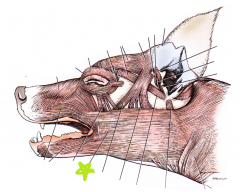
general action? Innervation? |
platysma m.
draw commissure of lips caudally (dorsal median raphe to the angle of mouth
dorsal and ventral buccal brs. and caudal auricular br. of facial n. (CN VII) |
|
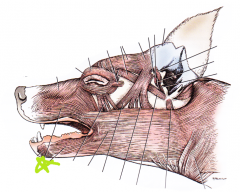
general action? innervation? |
orbicularis oris m.
close mouth opening, pull nose downward when sniffing, increase diameter of nostril (dilate)
dorsal and ventral buccal brs. of facial n. (CN VII) |
|
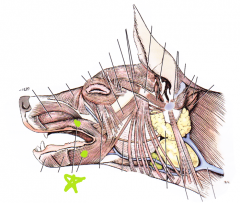
general action? innervation? |
Buccinator m. (deep to platysma, partially deep to orbicularis oris m.)
move food from vestibule to masticatory surface of the teeth
dorsal and ventral buccal brs. of facial n. (CN VII) |
|
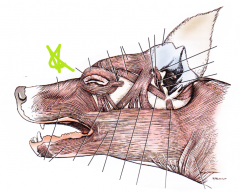
CN VI: dysfunction causes? |
medial strabismus due to pull of the medial rectus m. |
|
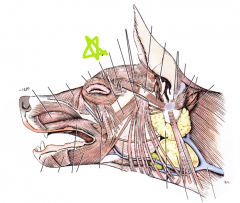
general action? innervation? |
zygomaticus m.
smile! (commissure of mouth dorsocaudal); draw scutiform cartilage and ear rostrally
auriculopalpebral br. of facial n. (CN VII) |
|
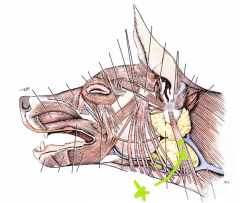
general action? innervation? |
parotidoauricularis m.
depress the ear
facial n. (CN VII) |
|

name? action? innervation? |
levator anguli oculi medialis m.
raises the eyelid
palpebral brs. of auriculopalpebral br. of facial n. |
|
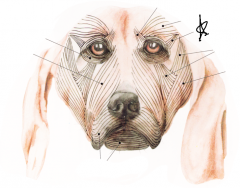
name? action? innervation? |
retractor anguli oculi lateralis m.
retracts lateral angle of eye caudally (squinting); covers lateral palpebral ligament
palpebral brs. of auriculopalpebral br. of facial n. |
|
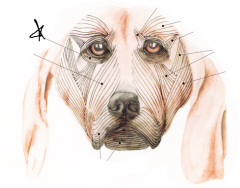
name? action? innervation? |
orbicularis oculi m.
closes palpebral fissure
palpebral brs. of auriculopalpebral br. of facial n. |
|
|
What are the extrinsic ear muscles? |
rostral/dorsal/caudal auricular mm. |
|
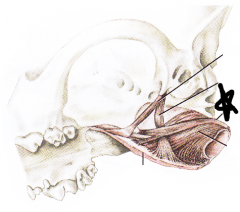
name? o/i? n? a? |
Pterygopharyngeus m.
hamulus of pterygoid bone to mid-dorsal raphe of the pharynx
CN IX and CN X
constricts pharynx and draws it forward |
|
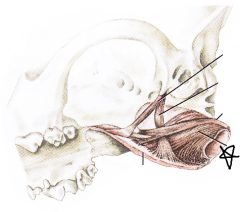
name? o/i? n? a? |
Palatopharyngeus m.
from soft palate to the mid-dorsal raphe of the pharynx
CN IX and CN X
constricts pharynx and draws it forward
|
|
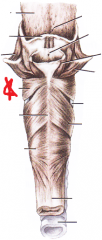
name? o/i? n? a? |
Hyopharyngeus m.
from thyroid and ceratohyoid bones to mid-dorsal raphe of the pharynx
CN IX and X
constricts rostral part of pharynx |
|
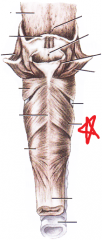
name? o/i? n? a? |
Thyropharyngeus m.
from thyroid cartilage lamina to the mid-dorsal raphe of the pharynx
CN IX and CN X
constricts middle part of the pharynx |
|
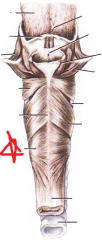
name? o/i? n? a? |
Cricopharyngeus m. (= upper esophageal sphincter)
from lateral surface of cricoid cartilage to the mid-dorsal raphe of the pharynx
CN IX and CN X
constricts caudal part of pharynx |
|

name? o/i? n? a? |
Stylopharyngeus m.
stylohyoid bone to rostrodorsal wall of the pharynx
CN IX and X
dilates, elevates, draws pharynx forward |
|

name? o/i? n? a? |
tensor veli palatini m.
muscular process at rostral border of tympanic bulla, over hamulus, to the palate
CN V
stretch palate between the pterygoid bones |
|
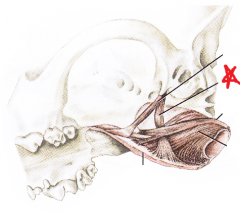
name? o/i? n? a? |
levator veli palatini m.
muscular process adjacent to tympanic bulla to the caudal half of the soft palate (passes between palato- and pterygopharyngeus mm.)
CN IX and CN X
raises the soft palate |
|
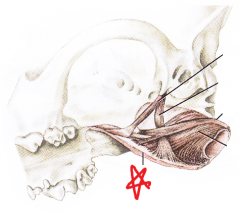
name? o/i? n? a? |
palatinus m.
palatine process of palatine bone to the caudal free border of the soft palate
CN IX and CN X
shortens soft palate |
|
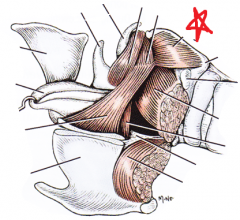
name? o/i? n? a? |
cricoarytenoideus dorsalis m.
dorsolateral surface of the cricoid cartilage and inserts on the muscular process of the arytenoid cartilage
CN X
rotates arytenoid so that the vocal process moves laterally- opens the glottis |
|
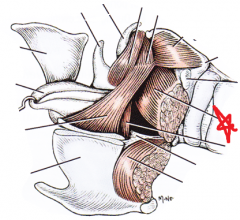
name? o/i? n? a? |
Cricoarytenoideus lateralis m.
lateral and cranial surfaces of cricoid cartilage and inserts on muscular process of arytenoid cartilage between insertion of cricoarytenoideus dorsalis m. and vocalis m.
CN X
closes glottis by pulling muscular process ventrally and thus move vocal process medially |
|
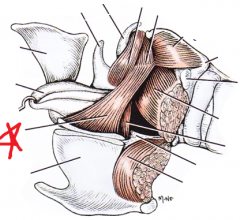
name? o/i? n? a? |
thyroarytenoideus m. (gives rise to vocalis and ventricularis mm.)
internal midline of thyroid cartilage, courses caudodorsally to insert on muscular processes of arytenoid cartilage
CN X
relaxes vocal fold and constricts glottis
relaxes vocal fold |
|
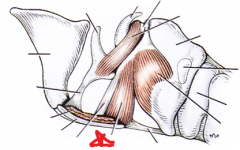
name? o/i? n? a? |
vocalis m.
courses from internal midline of thyroid cartilage to the vocal process of the arytenoid cartilage
CN X
draws arytenoid cartilage downward, relaxing vocal cords, lowers pitch of voice |
|
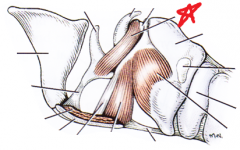
name? o/i? n? a? |
ventricularis m.
courses from cuneiform process of arytenoid cartilage to the interarytenoid cartilage dorsally
CN X
constricts the glottis |
|
|
innervation of the larynx:
name the 2 nn. and what they supply |
cranial laryngeal n. (from distal ganglion of vagus) -external br.: motor to cricothyroideus m. -internal br.: laryngeal mucosa (cough reflex)
caudal laryngeal n.: motor to remaining laryngeal mm.
|
|
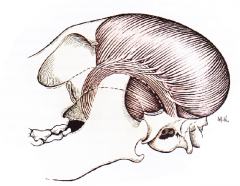
name? o/i? n? a? |
temporalis m. (STRONGEST IN THE HEAD)
O: temporal fossa I: coronoid process of mandible (medially; ventrally, as far as ventral margin of masseteric fossa)
N: mandibular n. of trigeminal n.
A: raise mandible in closing the mouth |
|
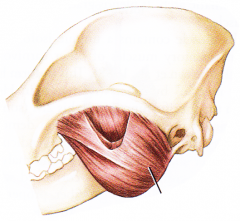
name? o/i? n? a? |
masseter m.
superficial layer (ventral border of z. arch--> ventrolateral mandible) middle layer (zygomatic arch to ventral margin of masseteric fossa) deep layer (medial surface of zygomatic arch to caudal part of masseteric fossa)
N: mandibular n. of trigeminal n.
A: raise mandible in closing the mouth |
|
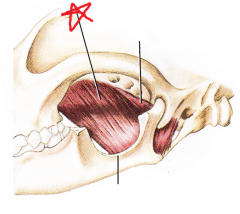
name? o/i? n? a? |
medial pterygoid m.
O: pterygopalatine fossa (pterygoid, palatine, sphenoid bones) I: medial and caudal surfaces of the angular process of mandible and ventral to insertion of temporalis and lateral pterygoid mm.
N: mandibular n of trigeminal n.
A: raise the mandible |
|
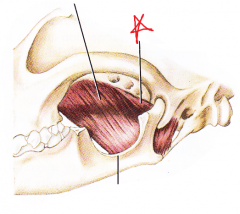
name? o/i? n? a? |
lateral pterygoid m.
O: small fossa in sphenoid bone (ventral to alar canal and orbital fissure)
I: medial surface of condyle of mandible, ventral to articular surface
N: mandibular n. of trigeminal n.
A: raise mandible |
|
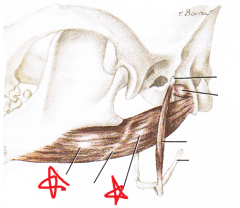
name? o/i? n? a? |
digastricus m.
O: paracondylar/juglar process of occipital bone I: ventromedial border of the mandible (further rostrally in cat)
N: rostral belly: mandibular n. of trigeminal n. caudal belly: facial n. |
|
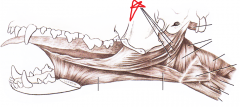
name? o/i? n? a? |
styloglossus m. (short, rostral, long heads)
O: stylohyoid bone I: tongue
N: hypoglossal n.
A: retract tongue
|
|
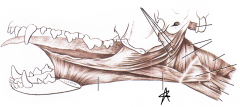
name? o/i? n? a? |
hyoglossus m.
O: ventrolateral surface of basihyoid bone and adjoining end of thyrohyoid bone I: root of tongue
N: hypoglossal n.
A: retract and depress the tongue |
|

name? o/i? n? a? |
genioglossus m.
O: intermandibular symphysis and adjacent body of mandible
I: midventral surface of tongue; also inserts on basihyoid and ceratohyoid bones
N: hypoglossal n.
A: depress tongue, caudal fibers draw tongue forward, rostral fibers curl tip downward |
|
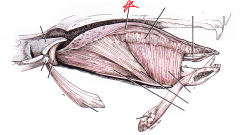
name? n? a? |
proper lingual mm.
dorsal and ventral LONGITUDINAL fibers, transverse and perpendicular fibers
a: protrude tongue, fine tongue movments
n: hypoglossal n. |
|
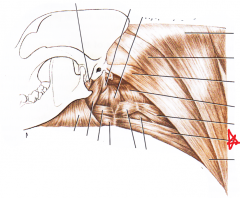
name? o/i? n? a? |
sternohyoideus m.
O: manubrium and first costal cartilage I: basihyoid bone A: draw basihyoid bone and tongue caudally N: ventral brs. of cervical spinal nn. +/- hypoglossal n. |
|

name? o/i? n? a? |
sternothyroideus m.
O: manubrium and first costal cartilage I: lateral surface of lamina of thyroid cartilage
N: ventral brs. of cervical spinal n.
A: draw hyoid app., larynx, tongue caudally |
|
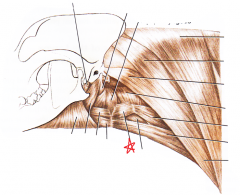
name? o/i? n? a? |
thyrohyoideus m.
O: lamina of thyroid cartilage I: caudal border of thyrohyoid bone
N: ventral brs. of cervical spinal nn.; hypoglossal n.
A: draw hyoid app caudally and dorsally |
|
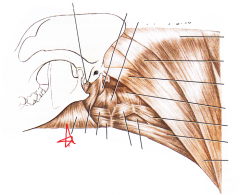
name? o/i? n? a? |
mylohyoideus m.
O: medial side of body of mandible I: median fibrous raphe and basihyoid bone
N: mylohyoid n. (br. of mandibular n. of trigeminal n.)
A: support tongue, raise floor of mouth, draw hyoid apparatus cranially |
|
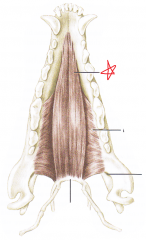
name? o/i? n? a? |
geniohyoideus m.
O: adjacent to mandibular symphysis I: basihyoid bone
N: hypoglossal n.
A: draw hyoid apparatus cranially |
|
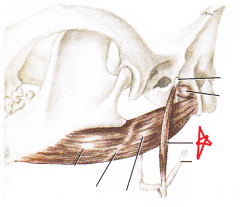
name? o/i? n? a? |
stylohyoideus m.
O: tympanohyoid cartilage and proximal end of stylohyoid bone I: basihyoid bone laterally
N: facial n.
A: raise basihyoid bone |
|
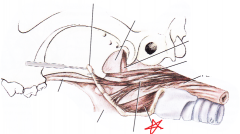
name? o/i? n? a? |
ceratohyoideus m.
dog: btwn thyrohyoid and ceratohyoid bones (sometimes epihyoid too)
cat: courses btn thyro-, cerato- and epihyoid bones
N: glossopharyngeal n.
A: decrease angle formed by thyrohyoid and ceratohyoid bones |

